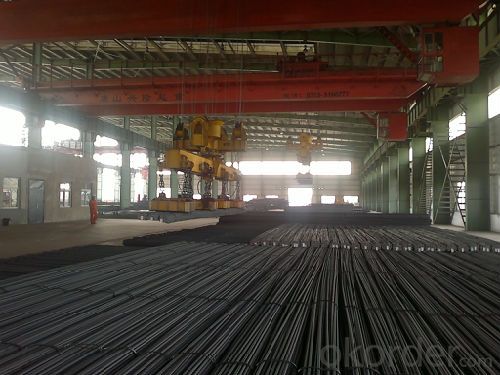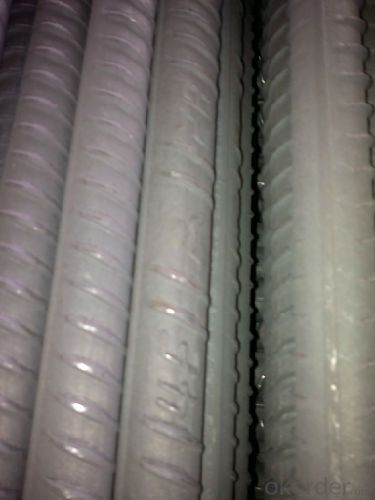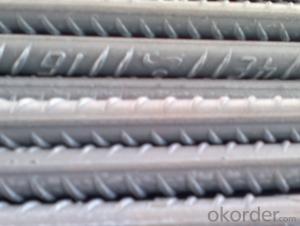Steel Rebars,Deformed Steel Bars,Building Material China Manufacturer
- Loading Port:
- Tianjin
- Payment Terms:
- TT or LC
- Min Order Qty:
- 50 m.t.
- Supply Capability:
- 20000 m.t./month
OKorder Service Pledge
OKorder Financial Service
You Might Also Like
Product Description:
OKorder is offering Steel Rebars,Deformed Steel Bars,Building Material China Manufacturer at great prices with worldwide shipping. Our supplier is a world-class manufacturer of steel, with our products utilized the world over. OKorder annually supplies products to European, North American and Asian markets. We provide quotations within 24 hours of receiving an inquiry and guarantee competitive prices.
Product Applications:
Steel Rebars,Deformed Steel Bars,Building Material China Manufacturer are ideal for structural applications and are widely used in the construction of buildings and bridges, and the manufacturing, petrochemical, and transportation industries.
Product Advantages:
OKorder's Steel Rebars,Deformed Steel Bars,Building Material China Manufacturer are durable, strong, and resist corrosion.
Main Product Features:
· Premium quality
· Prompt delivery & seaworthy packing (30 days after receiving deposit)
· Corrosion resistance
· Can be recycled and reused
· Mill test certification
· Professional Service
· Competitive pricing
Product Specifications:
Manufacture: Hot rolled
Grade: HRB335
Certificates: ISO, SGS, BV, CIQ
Length: 6m – 12m, as per customer request
Packing details Steel:Steel rebar packed in bundle or as your requirement
Delivery:Within 30 days after deposit
Diameter:10mm-40mm
Place of Origin:Fujian, China (Mainland)
Model Number:QZMM-ST001
Application:Building material, construction, road, bridge,etc
Product Name:Steel Rebars,Deformed Steel Bars,Building Material China Manufacturer
Standard:ASTM A615 /BS BS 4449 /GB HRB/ JIS G3112
Material:HRB335
Shape:Straight reinforcing bars
Technique:Low temperature hot-rolling reinforcing deformed steel rebar
Tolerance:As the standard or as your requirement
MOQ:100tons per size steel rebar
Packing details Steel:Steel rebar packed in bundle or as your requirement
Delivery:Within 30 days after deposit
Post:XIAMEN,CHINA
FAQ:
Q1: How soon can we receive the product after purchase?
A1: Within three days of placing an order, we will begin production. The specific shipping date is dependent upon international and government factors, but is typically 7 to 10 workdays.
Q2: What makes stainless steel stainless?
A2: Stainless steel must contain at least 10.5 % chromium. It is this element that reacts with the oxygen in the air to form a complex chrome-oxide surface layer that is invisible but strong enough to prevent further oxygen from "staining" (rusting) the surface. Higher levels of chromium and the addition of other alloying elements such as nickel and molybdenum enhance this surface layer and improve the corrosion resistance of the stainless material.
Q3: Can stainless steel rust?
A3: Stainless does not "rust" as you think of regular steel rusting with a red oxide on the surface that flakes off. If you see red rust it is probably due to some iron particles that have contaminated the surface of the stainless steel and it is these iron particles that are rusting. Look at the source of the rusting and see if you can remove it from the surface.
Images:


- Q:Can steel rebars be used in architectural detailing?
- Yes, steel rebars can be used in architectural detailing. Steel rebars are often used to reinforce concrete structures and provide additional strength and stability. In architectural detailing, rebars can be incorporated into the design to enhance the structural integrity of the building or to create unique and intricate patterns. Rebars can be bent, shaped, and placed in various configurations to achieve the desired architectural effect. Additionally, steel rebars are durable, resistant to corrosion, and readily available, making them a popular choice in architectural detailing.
- Q:Are steel rebars suitable for use in structures with high resistance to impact?
- Structures with high resistance to impact can generally make use of steel rebars. These rebars, also known as reinforcement bars, are made from steel and are commonly utilized in concrete structures to enhance their strength and durability. Steel possesses high tensile strength and the ability to absorb and distribute impact forces, making it an excellent material for reinforcement. In situations where impact is a concern, like in bridges, highways, or buildings located in earthquake-prone areas, steel rebars perform a critical function by providing additional strength and resistance. By incorporating rebars, the structure becomes capable of withstanding sudden impact loads and preventing catastrophic failures. Furthermore, engineers have the option to choose from various grades and sizes of steel rebars, ensuring that the appropriate type is selected based on the specific requirements of the structure. Higher grade rebars, such as Grade 60 or Grade 75, offer increased strength and ductility, making them particularly suitable for structures with high resistance to impact. It is worth noting that while steel rebars enhance the overall strength and impact resistance of a structure, other factors such as design, construction techniques, and maintenance also play significant roles in ensuring the structure's ability to withstand impact forces. Therefore, taking a comprehensive approach that encompasses all these factors is crucial when designing and constructing structures with high resistance to impact.
- Q:What are the common mistakes to avoid when installing steel rebars?
- Some common mistakes to avoid when installing steel rebars include improper placement or spacing of rebars, inadequate concrete cover, insufficient reinforcement overlap, incorrect bar bending or cutting, and neglecting to secure the rebars in place during concrete pouring. It is essential to follow the specifications and guidelines provided by structural engineers and adhere to industry standards to ensure proper reinforcement installation.
- Q:What is the process of epoxy-coating steel rebars?
- The process of epoxy-coating steel rebars involves several steps. First, the rebars are thoroughly cleaned and degreased to ensure proper adhesion of the epoxy coating. Next, the rebars are preheated to a specific temperature to enhance the coating process. Then, a primer layer of epoxy is applied to the rebars to create a strong bond. After the primer has cured, a topcoat of epoxy is applied to provide corrosion resistance and durability. The coated rebars are then allowed to cure and dry, typically in a controlled environment. Finally, the epoxy-coated rebars are inspected for quality and can be used in various applications such as reinforced concrete structures, where they provide protection against corrosion.
- Q:What is the process of bending steel rebars?
- The process of bending steel rebars involves using specialized tools and equipment to apply force and create a desired shape or angle in the steel bars. This can be done manually or with the help of machines such as hydraulic benders. The rebars are typically heated to a specific temperature to make them more malleable, and then they are carefully bent using the appropriate bending technique. The process requires skill, precision, and knowledge of the properties of steel and the desired bending specifications.
- Q:How are steel rebars measured?
- Steel rebars are typically measured by their diameter and length. The diameter is commonly measured in millimeters or inches, while the length is measured in meters or feet.
- Q:How do steel rebars prevent concrete structures from spalling?
- The reinforcement and increased strength provided by steel rebars prevent spalling in concrete structures. Spalling occurs when the concrete surface cracks and breaks off due to internal pressure from factors like temperature changes, moisture, or structural loads. When steel rebars are embedded in the concrete, they act as a support system that evenly distributes applied loads throughout the structure. This prevents localized stress concentrations, which can cause spalling, by absorbing and dissipating the load. By reinforcing the concrete, rebars enhance its ability to withstand external forces and improve its tensile strength. Furthermore, steel rebars help control crack formation in the concrete. Concrete is a brittle material with low tensile strength, making it prone to cracking under stress. However, rebars hinder crack propagation by bridging them and transferring the stress to the surrounding concrete. This prevents the cracks from spreading and results in a more durable and resilient structure. Additionally, steel rebars protect against corrosion. Concrete's natural alkalinity forms a protective layer on the steel surface, preventing rusting. This alkaline environment acts as a barrier against corrosion, ensuring the rebars maintain their structural integrity over time. By avoiding corrosion, the rebars can continue to reinforce the concrete and prevent spalling. In conclusion, steel rebars are essential in preventing spalling in concrete structures by providing reinforcement, improving tensile strength, controlling crack formation, and protecting against corrosion. They enhance the stability and durability of the concrete, allowing it to withstand external pressures and maintain its integrity for an extended period.
- Q:Can steel rebars be used in bridges and highways?
- Steel rebars are indeed suitable for utilization in bridges and highways. They are commonly employed as reinforcement in concrete structures, such as bridges and highways, to augment their strength and durability. The rebars are inserted into the concrete to provide supplementary tensile strength, which is indispensable for enduring the diverse loads and stresses that bridges and highways encounter. Steel rebars are favored due to their exceptional strength-to-weight ratio, resistance to corrosion, and ability to bond effectively with concrete. Furthermore, they can be readily fabricated and molded to meet the design specifications of the bridge or highway. All in all, steel rebars play a crucial role in the construction of bridges and highways, guaranteeing their structural soundness and long lifespan.
- Q:What is the role of steel rebars in ensuring occupant safety?
- Steel rebars play a crucial role in ensuring occupant safety in various structures, particularly in buildings and infrastructure. These reinforced steel bars are commonly used in concrete construction to enhance the strength and durability of the structure, ultimately safeguarding the individuals residing or working within them. The primary function of steel rebars is to provide structural reinforcement to concrete elements, such as columns, beams, and slabs. By incorporating rebars into the concrete, the overall load-bearing capacity of the structure is significantly increased, allowing it to withstand various external forces and loads. This greatly reduces the risk of collapse or structural failure, which could potentially harm the occupants. During seismic events, such as earthquakes, steel rebars play a critical role in dissipating and distributing the energy exerted on the structure. The ductility and tensile strength of steel allow it to absorb and distribute the seismic forces, reducing the chances of a sudden structural failure. This ensures that the occupants are protected from the potential hazards associated with seismic activity. Moreover, steel rebars enhance the fire resistance of concrete structures. While concrete itself possesses good fire-resistant properties, the inclusion of steel rebars further reinforces this resistance. Steel has a high melting point, and its thermal conductivity is relatively low compared to other materials. This means that steel rebars can withstand high temperatures for an extended period, ensuring the structural integrity of the building during a fire and providing occupants with a safe evacuation route. In addition to their structural benefits, steel rebars also contribute to the long-term durability and maintenance of the structure. By preventing cracks and minimizing the effects of corrosion, rebars help maintain the structural integrity of the concrete over time. This ensures that the occupants are not exposed to potential hazards caused by the deterioration of the structure. Overall, the role of steel rebars in ensuring occupant safety is indispensable. They provide structural reinforcement, increase load-bearing capacity, enhance fire resistance, and contribute to the long-term durability of a structure. By incorporating steel rebars into concrete construction, the risk of collapse, structural failure, and other potential hazards is significantly reduced, ultimately providing a safe environment for the occupants.
- Q:What is the impact of steel rebars on the sustainability of a structure?
- The sustainability of a structure is significantly influenced by steel rebars. To begin with, the usage of steel rebars improves the structure's durability and longevity. Steel is an incredibly durable material that can withstand harsh weather conditions, seismic activities, and heavy loads. Consequently, structures reinforced with steel rebars have a longer lifespan, reducing the need for frequent repairs or replacement. Moreover, steel rebars contribute to the structural integrity of a building. By reinforcing concrete, they help prevent cracks and fractures, ensuring the stability and safety of the structure. This, in turn, diminishes the risk of structural failure, which can have disastrous consequences. Regarding sustainability, the use of steel rebars also promotes resource efficiency. Steel is highly recyclable, with a recycling rate exceeding 90%. Consequently, at the end of a structure's life, the steel rebars can be easily recycled and reused, thereby reducing the demand for new steel production. This not only conserves natural resources but also decreases energy consumption and greenhouse gas emissions associated with steel production. Additionally, the use of steel rebars allows for flexibility in design and construction. They can be easily shaped and bent to meet specific structural requirements, resulting in more efficient use of materials and decreased waste. This flexibility also enables the construction of intricate and innovative structures, fostering architectural diversity and creativity. Lastly, steel rebars offer fire resistance, which is crucial for the safety of a structure and its occupants. Steel does not burn or contribute to the spread of fire, providing a higher level of fire resistance compared to other materials. This feature enhances the overall sustainability of a structure by reducing the risk of fire-related damage and loss. In conclusion, steel rebars positively impact the sustainability of a structure. They enhance durability, contribute to structural integrity, promote resource efficiency through recycling, enable flexibility in design and construction, and provide fire resistance. These factors collectively enhance the lifespan, safety, and environmental performance of a structure, making steel rebars a crucial component for sustainable construction.
1. Manufacturer Overview |
|
|---|---|
| Location | |
| Year Established | |
| Annual Output Value | |
| Main Markets | |
| Company Certifications | |
2. Manufacturer Certificates |
|
|---|---|
| a) Certification Name | |
| Range | |
| Reference | |
| Validity Period | |
3. Manufacturer Capability |
|
|---|---|
| a)Trade Capacity | |
| Nearest Port | |
| Export Percentage | |
| No.of Employees in Trade Department | |
| Language Spoken: | |
| b)Factory Information | |
| Factory Size: | |
| No. of Production Lines | |
| Contract Manufacturing | |
| Product Price Range | |
Send your message to us
Steel Rebars,Deformed Steel Bars,Building Material China Manufacturer
- Loading Port:
- Tianjin
- Payment Terms:
- TT or LC
- Min Order Qty:
- 50 m.t.
- Supply Capability:
- 20000 m.t./month
OKorder Service Pledge
OKorder Financial Service
Similar products
New products
Hot products
Related keywords






























